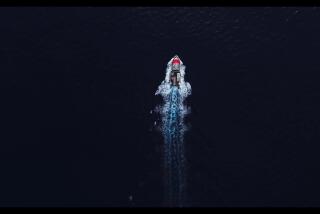Albatross Flies Again in Memory : Pilot, Crew to Gather on 10th Anniversary
- Share via
It’s a big, awkward-looking flying machine that sits in a hangar-like building in Pasadena, with a 96-foot stretch of transparent wings, a cockpit like a hunge plastic bag and a stabilizer that dangles from a pole at the nose.
But its twin, the Gossamer Albatross, gamely made it across the English Channel 10 years ago, driven only by pedal power. It was the only time a human-powered aircraft had ever accomplished such a feat, for which its creators won a $200,000 prize.
Those who built the airplane, many of them from the Pasadena area, and the support crew for its history-making 2-hour, 49-minute flight will gather Saturday for a private reunion in the Rosemont Pavilion, a cavernous building where workers assemble floats for the Tournament of Roses parade.
Reminiscing on Agenda
There they will reminisce about the flight, don 10th anniversary T-shirts and talk about the impact of the flight of the Gossamer Albatross.
“Just a get-together,” explained Paul MacCready, the Monrovia aeronautics engineer who designed the plane. But also, he said, a time to ask: What did it all mean?
On June 12, 1979, a young pilot and hang-gliding enthusiast from Altadena named Bryan Allen sat on the bicycle-like driver’s seat and pedaled the craft 23 miles from Folkstone, England, to Cap Gris Nez, France, the low-hanging cockpit barely skimming the sea.
MacCready recruited Allen as the pilot because of his unique skills as a pilot, bicyclist and hang-glider flier. “I was the right man at the right place,” Allen said.
Allen and MacCready were in Pasadena Thursday, reassembling Gossamer Albatross II, one of two backup planes for the cross-Channel flight, and recalling their 1979 triumph. The original Albatross hangs in the central atrium of the London Science Museum.
“It’s pretty amusing,” said Allen, 36, a thin, owlish-looking man, still within a couple of pounds of his flying weight of 137. He gave the airplane, whose nine major pieces he and MacCready had assembled the evening before, a critical once-over. “Last night we kept having to refer to a drawing made by an English model company to remember where all the wires were.” Allen, a computer software specialist with a Pasadena firm, recalling the grueling flight, said, “It was by far the most difficult thing I’ve ever done physically . . . and, I suppose, mentally.”
The Albatross, 70 pounds of carbon filament tubing, Mylar polyester film and a few other odds and ends, held together largely with Scotch tape, is indeed an awkward instrument, Allen said. “Modern fighter planes have an on-board computer to keep them stabilized,” he said. “But in this case, the on-board computer was the pilot. Hands off meant you crashed. It had to be flown 100% of the time.”
Notes Ripple Effect
Flown and pedaled. Allen soon discovered that ripples on the ocean create ripples in the air. “There was much more interaction between air and water than we had expected,” he said.
An hour or so into the trip, the plane started running into head winds. A half-hour later, Allen was ready to quit. Pulling the plane up so that a boat that was accompanying him could fasten a towline to it, he discovered “serendipitously” that things were a lot calmer at an altitude of 20 feet than they had been at five feet.
The last leg of the journey was sheer agony, Allen said. Without water, he was dehydrating, his legs started to cramp and the Albatross was showing a “willful unpredictability” in the gusting air.
But the alternative to crashing kept him going, Allen said. “I kept thinking that I didn’t ever want to have to do this again,” he said.
Finally, avoiding the temptation to crash-land against some sea-dashed rocks near the French coast, Allen and the Albatross veered out of the air onto the beach, where crew members had to help him stand up.
“By then, I didn’t want to spend another tenth of a second in the plane,” he said.
When he staggered out of the plane onto a French beach, Allen exulted “I feel tired, but . . . whooee!”
Little Impact on Technology
The long-range consequence of the flight? It had little practical application to aeronautic technology, conceded MacCready, 63, whose firm specializes in alternative energy research and services. He is the creator as well of a pair of solar-powered aircraft and a radio-controlled flying replica of the long-extinct pterodactyl, called “Quetzalcoatlus northropi.”
Some of the aircraft’s materials are getting wider uses now. “Carbon filament and Kevlar (a compound used in some of the control mechanisms) are sneaking their way into airlines,” he said.
The $200,000 prize, the largest cash prize in aviation history, put up by English industrialist Henry Kremer, all went to cover expenses.
But the flight of the Gossamer Albatross was more symbolic than anything, said MacCready, comparing it to Charles Lindbergh’s 1927 flight across the Atlantic.
The Spirit of St. Louis “changed the world,” he said. “It got the idea of transportation flight going.”
The Albatross’ arduous swoop across the English Channel symbolized a more modern idea, he said. “It helped change people’s perceptions about how we can do more with less,” MacCready said. “We’ve reached an era of limits on Earth, so it (the message) is really important.”
More to Read
Sign up for The Wild
We’ll help you find the best places to hike, bike and run, as well as the perfect silent spots for meditation and yoga.
You may occasionally receive promotional content from the Los Angeles Times.






